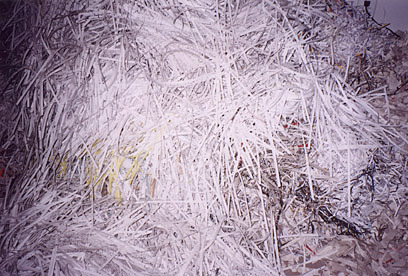
|
Gallery One One One, September 7-October 14, 2000 Interview with Eduardo Aquino by Cliff Eyland "111101" takes as its starting point the idea that information and knowledge have become forms of currency in contemporary life. Eduardo Aquino's project makes this idea wittily - even anarchistically - visible. Aquino's exploration uses magstripe technology to move around refuse from libraries and offices. Two installations (one in Winnipeg and one in Ottawa) mimic and "communicate" with each other through the use of an electronic device and via a linkage over the Internet. Interactive devices, including sensor-activated objects, cameras, projections, light, sound and movement, animate and synchronically activate both gallery spaces. Viewers are asked to use one of their own magstripe cards to get the machinery going. According to Aquino, such viewer participation "engages a collective community body in an interdisciplinary process, while serving as an active learning and creative experience. The objective is to explore new forms of cross disciplinary exchange in a real, dynamic and engaging enterprise. C.E.: You are an architect and artist. Would you characterize this installation as "architectural practice" and if so, how? E.A.: 111101 is the result of a thought process that goes back to my first installation works in Rio de Janeiro in the late 80s, when I started to address the issue of preconception about the gallery space. The gallery is one of the most charged spaces in our culture, starting with its regular box-like architecture and the fact that it suggests 'neutrality' by being white. [In the 60s and 70s] Helio Oiticica and Lygia Clark, in Rio, directly addressed the problem of participation in the art experience and created a profound rupture in the way we understand the gallery space and our relationship with the art object. Today we are going through another transformation. The art object itself is dissolving and as technology more and more becomes a part of our everyday lives it carries the power to unconsciously alter our perceptive states. I'm also interested in how digital technology can transform the perception of a space. C.E.: You mentioned some people's difficulty with the "magstripe" aspect of your installation [see illustration above, which shows the results of a magstripe card activated paper shredding machine. Gallery visitors had to swipe one of their own magstripe cards through the machine to automatically start the shredder]. Could you elaborate on this? E.A.: A friend of mine told me that he would never sweep his card in the installation because he doesn't 'trust' where the information is going. I replied to him saying that when he goes to a store, or to an ATM he never considers where his personal information goes because he is getting something instantly back which is valued as a consumer product. I think (111101) tries to critically expose this daily automated gesture simply because the 'product' you are getting back is not a consumer product but rather an artistic experience.
Information: Robert Epp
eppr@ms.umanitoba.ca or Eduardo Aquino at
aquinoe@cc.umanitoba.ca |
